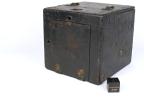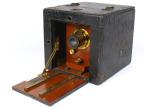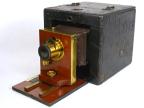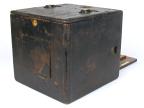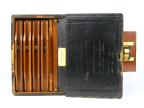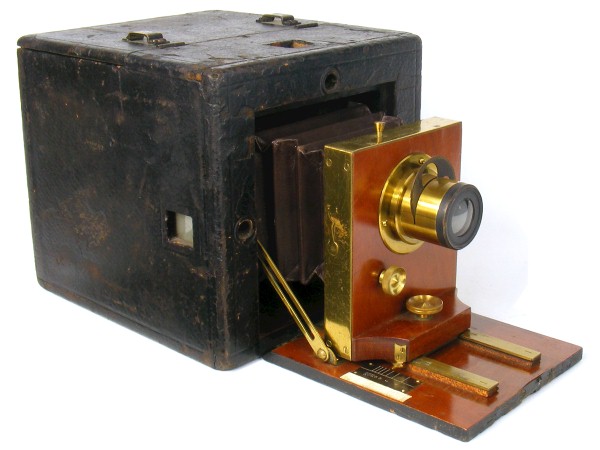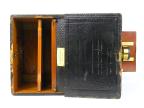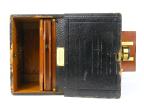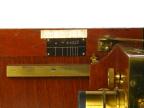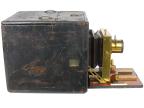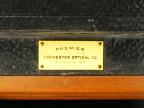Premier Camera
Rochester Optical Company
| Model / Variant: | Early model with shutter integrated into the lens standard (see description). |
| Plate / Film Size: | 4 x 5 plates or rollholder. |
| Lens: | Unmarked with wheel stops, but likely to be rapid rectilinear |
| Shutter: | Integrated shutter built into lens standard (see description) |
| Movements: | None |
| Dimensions (w x h x l): | 17.5 x 17 x 19 cm (closed) |
| Date of this Example: | c1892 |
| Serial Number: | Serial 56 marked on inside of front door (bed). |
| Availability: |
|
| Inventory Number: | 630 |
|
Photos copyright © 2014 David Purcell. Do not use without permission. |
Description
The maker of the Premier camera is identified as the Rochester Optical Co on the ivory / bone label inside the ivory / bone label inside the rear access door, together with the Premier name. This particular variant of the maker's name limits the date to the period between 1883 and 1899; McKeown gives the date as c1891.
The Folding Premier is a 4 x 5 plate camera, with integrated two-speed shutter. According to advertising of the time, the body was available in two sizes: one could hold 4 DDS and the other 6 DDS, the latter form being of greater length to accommodate the additional DDS. This example is the shorter 4 bay model.
It has an interesting ground glass screen finder, which rather than being removed from the camera to load the DDS, is released by pins and travels towards the back of the camera on rails by just enough to allow a DDS to be inserted in front of it. The camera has a rear access panel (hinge broken on this example) that allowed a direct view of the ground glass screen, provided all the DDS were removed of course!
The Rochester Optical Company introduced its version of a self-casing camera, the Folding Premier "Hand and Stand" Camera, in 1892 and was intended to compete with cameras such as the No 4 Folding Kodak, Blair Folding Hawkeye, but was quite a lot cheaper than these competing models.
The 1892 Folding Premier has a rare feature not found on any other self-casing camera. Inside the lens board is a surprisingly sophisticated clockwork shutter capable of shooting six exposures. This feature is also found on the earliest versions of the Rochester Optical Premier box cameras (but not my later example). While the shutter can rapidly fire six times after being wound, the photographer still had to change plates or wind film in the rollholder between exposures.
There were at least two models. The earlier form has the shutter built into the lens panel (that is, the components were not exposed), as with this example. The later model has a more conventional lens standard and separate shutter. The first model has two built in viewfinders for portrait and landscape format, much like the Premier box camera. It does not have a viewfinder mounted on the bed. The later model apparently disposed of the built in viewfinders in favour of a bed reflex finder.
Sadly the original leather covering is in rather poor condition, although still reasonably presentable. This seems to be a common problem with cameras produced by this maker, where the leather covering can often be in a distressed condition unless the camera has been carefully stored and little used.
Notes
The Premier camera turns up from time to time but is seldom in good condition. Almost every example I have seen so far has had issues with its leather covering which either has significant damage or has been recovered (as in this case).
If you have an example of this camera (in either the early or late variants), please contact me with further information about the shutter assembly and serial number.
You might like to compare this camera with the Premier box camera by the same maker. The two cameras are shown side by side in the photograph below.
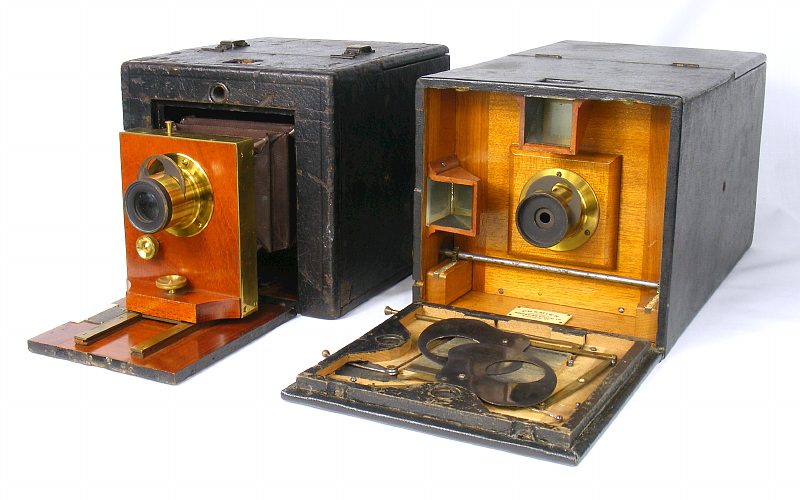
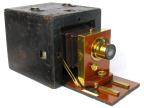
![[ ]](../../images/unchecked.png)
![[x]](../../images/checked.png)
